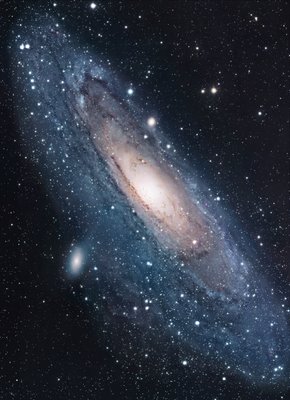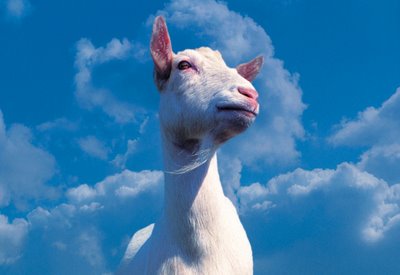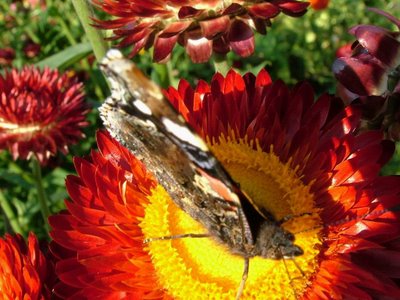Big 5 From Africa
Mention a safari to Africa, and one animal springs immediately to mind - lion! This, the so-called King of Beasts, is on everybody's list of animals to see. This fascination is no doubt due to the size and awesome power of this large cat, and its hunting prowess. But it may also have something to do with the human psyche, for our hominid ancestors on the African plains had to contend with lions as competitors and enemies on a daily basis. Perhaps they still dwell deep in our subconscious mind!
Gardeners of the Savannah The African Elephant is the largest land mammal and perhaps the continent's most charismatic creature. Few animals are as closely linked to the welfare of mankind - for elephants have the potential to greatly modify the vegetation of landscapes, destroy the crops of subsistence farmers as well as create wealth through their valuable ivory tusks. There is little doubt that elephants have played a vital role in the economic history of the continent. Today, visitors to Africa's wildlife reserves and wilderness areas are captivated by the power and grace of these magnificent animals and by their apparent sensitivity and compassion.
 WHITE RHINOCEROS - Great Grazer
WHITE RHINOCEROS - Great Grazer
Perhaps the first thing people wonder about the white rhinoceros is why it has its name. It is certainly not white in colour and actually has the same skin tone as its cousin, the black rhino. In fact, the name is thought to have been derived from the Dutch word "weid" meaning "wide" in reference to the animal's broad, wide mouth.
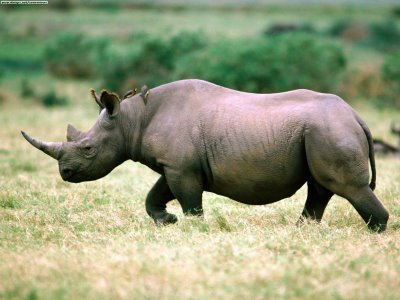
BLACK RHINOCEROS - Black Beauty
The Black Rhinoceros has a hooked, prehensile nose, carrying its head high on its shoulders, as opposed to the low-hanging head and hump-shoulders of its relative, the grazing White Rhino. Predominantly a browser of short woody trees and shrubs, the Black Rhinoceros uses its pointed upper lip to grasp leaves and twigs, employing its double horns to dig roots or break branches too far out of reach. Its grey, wrinkled skin varies in colour due to the mud and dust in which it frequently wallows to cool down and protect against flies and sun. The two species of African rhino are similar in height, averaging about 1.6m at the shoulder, but the Black Rhinoceros has roughly half the mass of a White Rhinoceros, weighing in at a demure 1000 kg.
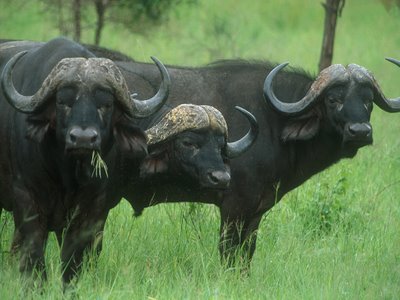 BUFFALO - Flanks of Ebony, Horns of Steel
BUFFALO - Flanks of Ebony, Horns of Steel
A large herd of buffalo is an unforgettable sight. Heads raised, horns glinting, massive fringed ears and noses twitching in search of danger. Closely related to the domestic cow, the African buffalo is one of the most successful and perhaps ecologically important mammals on the African continent. Buffalo are completely dependent upon surface water, so are absent from arid and semi-arid regions but are widespread and common in savannah, woodland and forest environments. Not surprisingly, however, they provide good meat and few now survive beyond the borders of wildlife reserves and other protected areas. Buffalo are also host to several diseases which are lethal to domestic cattle and so have been eliminated from areas suitable for ranchlands.
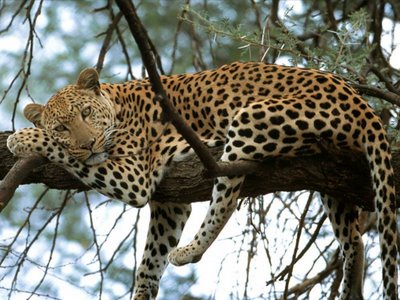 LEOPARD - Prince of Darkness
LEOPARD - Prince of Darkness
Few animals possess the mysterious aura of the leopard. 'Prince ofDarkness' and 'Silent Hunter' are frequent epithets for this traditionallyelusive cat. Like the lion, the leopard has been held in awe by generationsof people across Africa, the Middle East and Asia. Although an infrequentman-killer, leopards elicit fear and dread among rural people whosedomestic animals may be at risk to these cunning predators. The leopard isthe most adaptable of the large predators and may still be found in closeproximity to man, even, sometimes, on the outskirts of large cities. It is ableto survive in just about any environment, being at home in forest,savannah, desert, or mountain top. The body of a leopardwas once found in the snowfields on Mount Kilimanjaroat an altitude of some 4500 metres!
Ultra Deep Field
Astronomers at the Space Telescope Science Institute today unveiled the deepest portrait of the visible universe ever achieved by humankind. Called the Hubble Ultra Deep Field (HUDF), the million-second-long exposure reveals the first galaxies to emerge from the so-called "dark ages," the time shortly after the big bang when the first stars reheated the cold, dark universe. The new image should offer new insights into what types of objects reheated the universe long ago.
Top 10 Amazing Hubble Photos

Hubble's coverage of light of different colors (its "spectral range") extends from the ultraviolet, through the visible (to which our eyes are sensitive), and into the near-infrared. Hubble's primary mirror is 2.4 meters (94.5 inches) in diameter. Hubble is not large by ground-based standards but it achieves heroically in space. Hubble orbits Earth every 97 minutes, 575 kilometers (360 miles) above the Earth's surface.
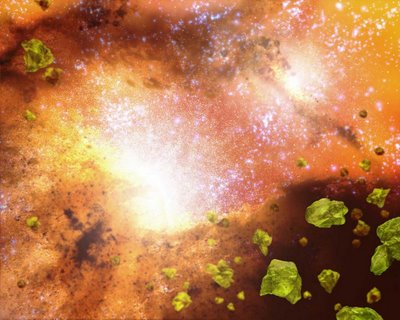 Deep space
Deep space 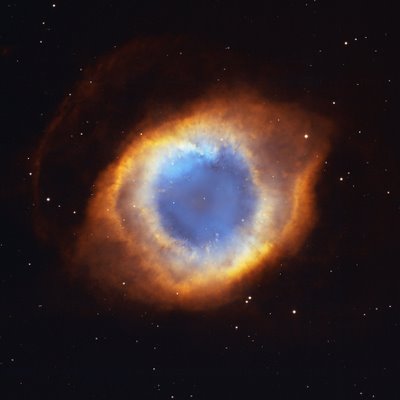 Eye-catching celestial helix
Eye-catching celestial helix Hubble's view of the Antennae galaxies
Hubble's view of the Antennae galaxies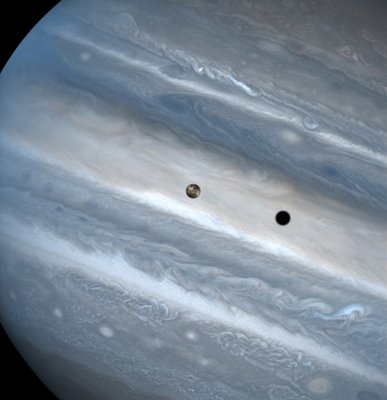 Jupiter's moon Io casts a shadow as it transits Jupiter
Jupiter's moon Io casts a shadow as it transits Jupiter Whirlpool Galaxy M51
Whirlpool Galaxy M51Chipmonk Ninja vs. Cat
The cat was no match for this chipmonk's ninja skills.
Aurora (Northern Lights)
Aurora borealis in time lapse. Images taken from BC, Canada.
Carnivorous Plants
So what about the Venus Flytrap? Is it an exception to this law of nature? Venus Flytraps are carnivorous, or meat-eating, plants. A fly that lands on a Venus Flytrap had better beware. A fly that lands on a Venus flytrap is history; it's lunch, a protein packed meal for a plant. Venus's-flytrap is probably the most recognizable of all sundew plants. It has hinged leaves that close and trap insects venturing into the open trap. The inside of each leaf has tiny hairs, and the rim is edged with long interlocking, stiff bristles. The closing of the trap is triggered by any pressure applied to six hairs, three on either side of the traps lobes. After the plant has captured the insect, a sap is secreted and digestion begins, which can take up to ten days. After the insect is digested the trap opens again to await the next victim. The trap will usually die once three or four insects are digested.
The Venus Flytrap is not an exception to the laws of nature. It is one of over 600 types of carnivorous plants! Carnivorous plants are like other plants in many ways. They even use photosynthesis to make most of their own food. They are carnivorous for a reason. Most carnivorous plants live in swampy wetlands. This environment does not provide enough of the nutrients that plants need, especially nitrogen. So these plants have adapted to their environment by developing ways to catch insects for the extra nutrition that they need. It is a survival tool.
 A plant must be able to do three things to be considered carnivorous. It must attract insects or other creatures; it must trap them; it must eat them.
A plant must be able to do three things to be considered carnivorous. It must attract insects or other creatures; it must trap them; it must eat them.Lots of the other meat-eating plants are grouped under the titles sundew, pitcher plant, and bladderwort.
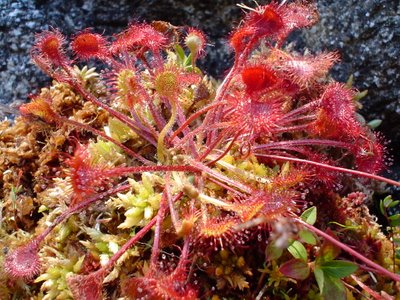 Sundew plants grow hairs on their leaves that produce a sticky substance that contains digestive juices. When an insect gets stuck on this substance, the hairs wrap around it or the leaves close. More fluid then covers and suffocates the insect which is then digested by the plant.
Sundew plants grow hairs on their leaves that produce a sticky substance that contains digestive juices. When an insect gets stuck on this substance, the hairs wrap around it or the leaves close. More fluid then covers and suffocates the insect which is then digested by the plant.  The Sundew plant tempts insects with its sticky drops
The Sundew plant tempts insects with its sticky drops
Pitcher plants have tube-shaped leaves that collect rain water in which the unsuspecting insects are drown. A sweet nectar secreted around the rim of each tube on the pitcher plant attracts insects. When the insect enters the tube, tiny, stiff hairs pointing downward prevent it from escaping and eventually force the exhausted insect into the water. The plant then digests the insect by means of an enzyme secreted by glands located in the leaves.

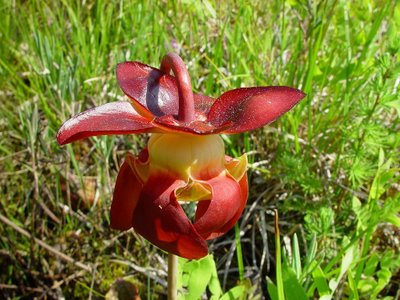
Pelican Eats Pigeon
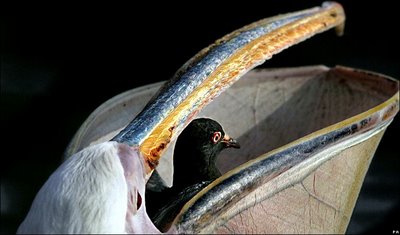
Spectacular Photo of Shuttle, Space Station And The Sun
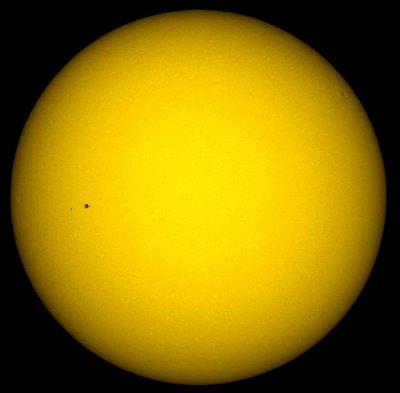 What looks like a small speck on the photo above, when you take a closer look below, you suddenly see the space shuttle and space center.
What looks like a small speck on the photo above, when you take a closer look below, you suddenly see the space shuttle and space center. The image was taken in Normandy by French astrophotographer Thierry Legault. He used a digital camera attached to a £5,000 specially kitted-out telescope.
The image was taken in Normandy by French astrophotographer Thierry Legault. He used a digital camera attached to a £5,000 specially kitted-out telescope.
The shuttle, which returned last week from a 12-day mission, and the space station can be seen in orbit 250 miles above the earth while the sun is 93 million miles away.
Pictures Of Steve Irwin's Death
The events were caught on camera, and a copy of the footage was handed to the Queensland Police[45]. After reviewing the footage of the incident and speaking to the cameraman who recorded it, marine documentary filmmaker and former spearfisherman Ben Cropp speculated that the stingray "felt threatened because Steve was alongside and there was the cameraman ahead". In such a case, the stingray responds to danger by automatically flexing the serrated spine on its tail (which can measure up to 25 cm or about 10 inches in length) in an upward motion.
Cropp said Irwin had accidentally boxed in the animal. "It stopped and twisted and threw up its tail with the spike, and it caught him in the chest. It's a defensive thing. It's like being stabbed with a dirty dagger". The stinging of Irwin by the bull ray was "a one-in-a-million thing".
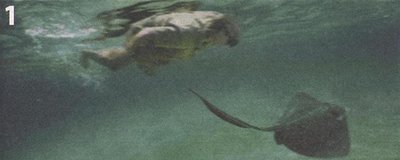
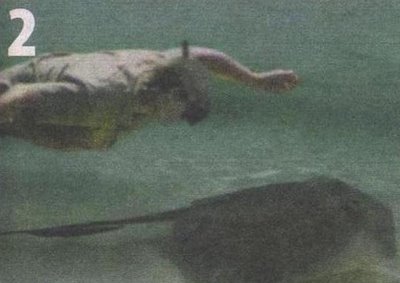
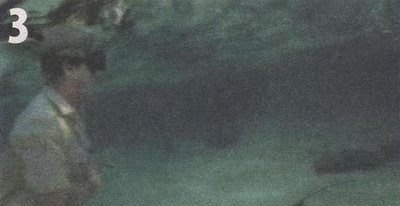 This is an artist recreation of what happened.
This is an artist recreation of what happened.
Zebra beats Lioness
In mighty struggle between lioness and zebra, zebra prevails.














